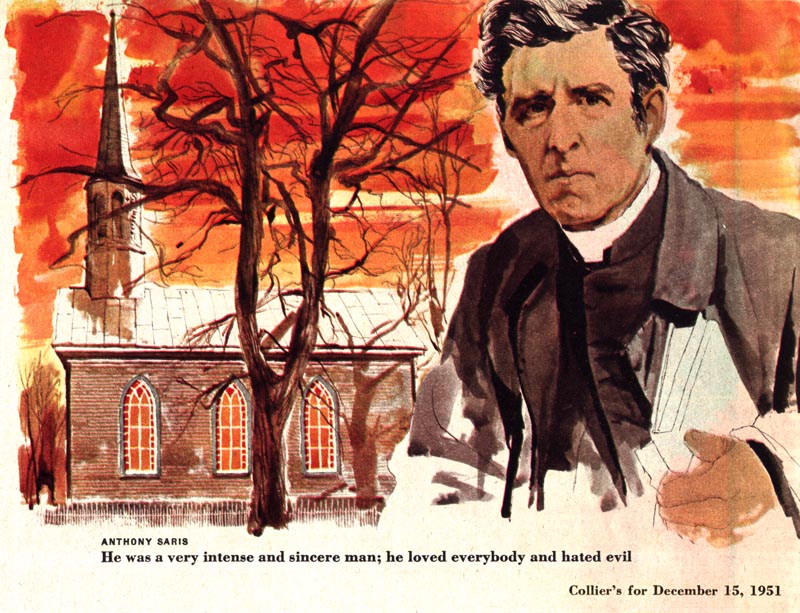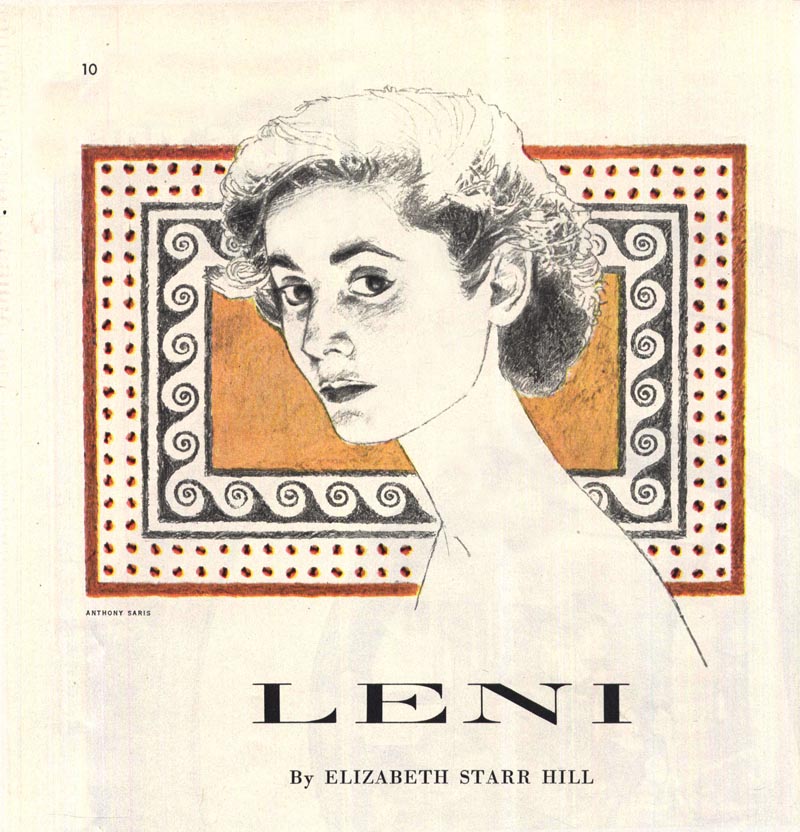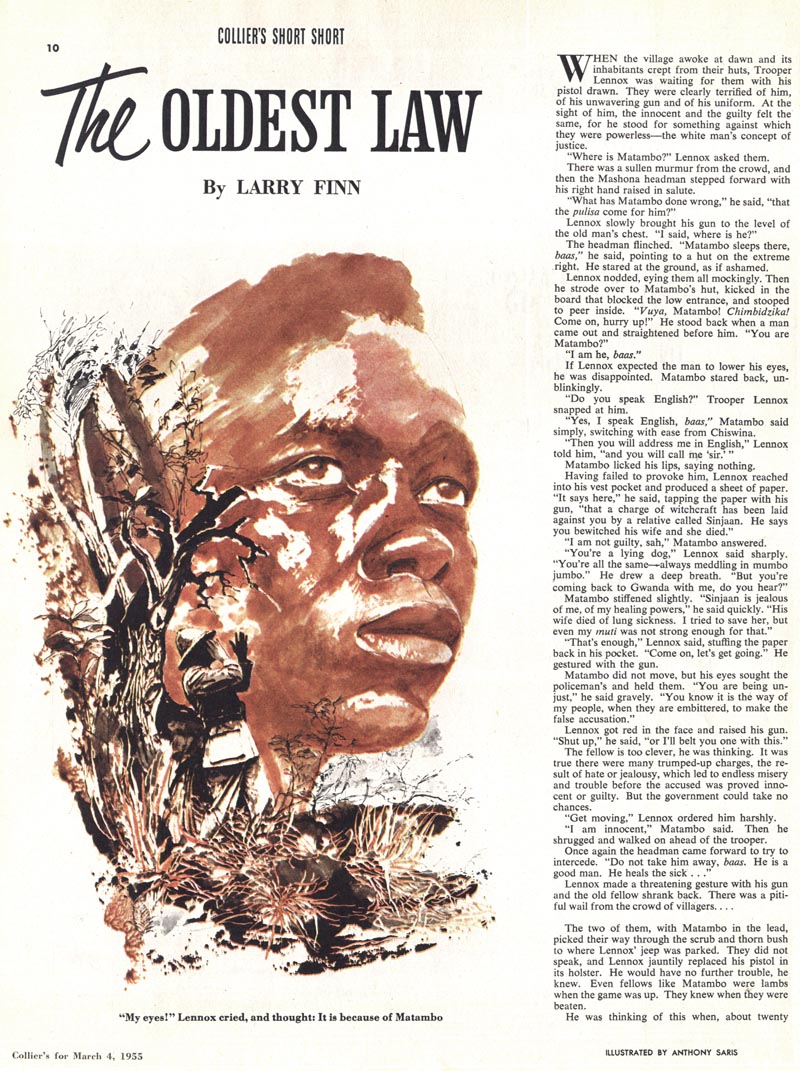
Anthony Saris was born in Joliet, Illinios and moved to New York from Chicago at age 11. He studied illustration at the Pratt Institute in Brooklyn and graduated in 1947.
You are looking at the kind of work he did about 5 years into his professional career.

This makes his mid-'50s stylistic development seem all the more remarkable. Below, a Saris piece for Collier's from 1954.

Saris did occasionally do his finished drawings in pencil, and this looks like it may have been one of those occasions.
"Sometimes," Saris said in his 1959 American Artist interview," I use colored crayons instead of ink, or any other expedient that may come to mind. I am willing to try anything new."

Below, a 1955 Collier's piece that dramatically shows the artist's work at the point of transition: Saris does part of this piece in his then new straight-to-ink line style, is beginning to experiment with his frisket resist technique and employing a more traditional painting method from his earlier days.

Saris, the "perfectionist experimenter", was described as "technically ... a rapid worker."
But his illustration production was relatively slow. Saris said that he would work on an image for quite some time in his mind before beginning to draw. As well, he said he would pose himself in a mirror or study passers-by. "Snapshots are helpful, principally to show detail," he said, "as well as sketches, and needless to say I have a sizable file of study material such as all illustrators assemble."
"In the case of important figures for an illustration, I prepare a separate and carefully planned drawing, photo or example from which I can make my finished ink drawing without hesitation."

Less than 10 years into a successful freelance illustration career Anthony Saris began teaching fourth-year illustration courses at his old alma mater, Pratt. No doubt he taught his students what he himself had so rapidly learned from experience: "The changeover from study to production usually provides a severe jolt for the graduate," said Saris, "caused by the sudden and largely unforeseen reversal of direction or goal. In school the laurels are awarded for the accumulation of knowledge, but when one enters the field of industry the emphasis shifts instantly to the use of knowledge. Employers are seldom impressed by our erudition, but they are interested in what we can do with it for them."
"In school we are fired with idealistic zeal, while at the same time we sense that commercialism has a slightly sordid connotation. We are afraid that 'they' will try to make commercial hacks of us. We must be true to our art and keep it pure, but nevertheless we need money."
"After I first established myself as a free-lance illustrator I resolved to devote my weekends to landscape painting, and I followed that resolution for a while. The purpose was to improve my art - as well as to enjoy myself - but principally, I suspect, to salve my artistic conscience, for the term 'commercial' still annoyed me. Then I realized I was foolishly competing with myself. I began to see the only difference between 'fine' and 'commercial' art is in the mind of the artist himself; that he becomes a hack only if he allows others to so convert him."
"If he follows an uncompromising course in art ethics and production his output can be esthetically pure."
* My Anthony Saris Flickr set.
It's interesting to read the experiences and philosophy of various illustrators. It seems that they fall into several categories. The Bernie Fuchs type that never seemed to have a problem with calling himself an illustrator, and had a natural desire to experiment and change techniques and methods frequently. The Robert Weaver type, who used avant-garde fine art as his inspiration, and agonized over being an illustrator and taking any kind of direction from an art director. The Morton Roberts type, a fine artist turned illustrator, staying traditionally literal in his painting approach, but aiming toward mural painting and other more gratifying venues. And then Anthony Saris, who was perhaps somewhere in between all of the above types. It seems he more or less reconciled with being an illustrator, choosing a style that the art directors preferred, but experimenting and expanding on it, within acceptable limits.
ReplyDeleteI believe it's about different personalities. It's what works for each individual's temperament... there was no one size fits all, in such a fast changing diverse profession.
Tom Watson
There are plenty of artists whose work changes dramatically over the years, so much so it's hard to identify them as being fromt he same hand. From these it appears to me that Saris seemed to maintain a similar manner of drawing, but played around with the presentation quite a bit.
ReplyDeleteThis comment has been removed by the author.
ReplyDelete